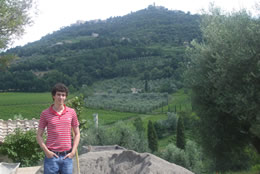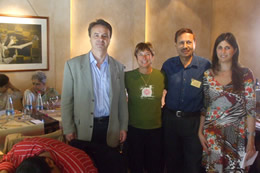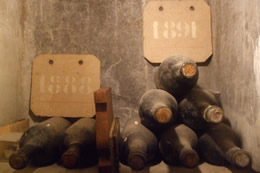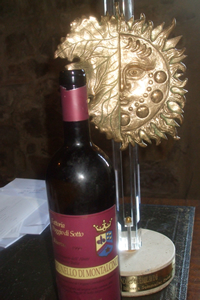One of Italy's top three red varietals is Brunello di Montalcino, a long living, complex and well structured wine produced from Sangiovese Grosso. However, the young and vivacious Rosso di Montalcino from the same vine costing less than a third may be ideal alternative for the tax ridden Indian market, feels Subhash Arora
Montalcino is an obscure, medieval and beautiful town 40 kms South of Siena, the boundary of Chianti Classico region. It stands on a hill which stands out like an island it the heart of Tuscany. After a seemingly never ending journey from Delhi to Rome via Munich (Italy is no more connected directly with India - che peccato! what a pity!), a tired you are dismayed that another 250 kms are still to be covered back North.
Reaching Montalcino
 |
| A View Of Capanna Vineyards |
Driving much lesser distance from Mumbai airport to Nashik vineyards takes me 5-6 hours, the journey usually made less arduous because of the company and beautiful ghaats en route. We are fortunate to cover the distance to Montalcino in about two and a half hours in the Mercedes mini van arranged by the hosts.
Time goes by quickly, enjoying the seaside on our left for the first 40 kms and then the beautiful country-site. Big plots of vineyards with small boards displaying Col d'Orcia, Banfi, Suga and Argiano with our guide-chauffer pointing to the Castello di Argiano and Castello di Banfi through the Mumbai monsoon type downpour signal that we are about to reach our abode for the next four days.
El Brunello
Our first encounter with brunello was- not the wine but the hotel. El Brunello is the hotel you pass by, just before entering Montalcino. The all-in-one manager, concierge, barman et al. of the 4-star small property was awe-struck by the congregation of a record number of Indians he encountered for the first time.
The dinner laid out in the restaurant had, at our special request- mostly vegetarian entrees which included riso, pasta, polenta, salads, cheeses to remember a few. What was common to all was Rosso di Montalcino 2006 from San Lorenzo. Everyone concurred that it was a very enjoyable wine. Mildly tannic, fruity and medium body wine was easy drinking and it was a love at first sight for most of the group, 'the delwine 14'.
Think Brunello
 |
| Stefano Campatelli (L) With Michele Shah and Stefania Tacconi (R) |
The tasting organised by the hosts, Consorzio Del Vino Brunello Di Montalcino at the new office in downtown Montalcino next day had 64 bottles opened and ready to taste. There are over 210 producers out of a total of about 250 producers/growers of brunello grape, who are members of the Consorzio. Stefania Tacconi of the Consorzio del Vino Brunello di Montalcino who had worked hard to make this tasting a reality tells us that all producers are members of this Association-this must be a record of sorts.
A few of these wines had already been present at the Vinitaly India Tasting and Seminar conducted in January this year by Michele Shah, the visit co-ordinator. However, in the short time of a couple of hours I managed to taste 44 labels.
My personal notes show ratings of the wines varying from 3.5/5 to 4.75/5. Most of the Brunellos were of very good to outstanding quality. All were 2003 vintage, released on January 1 this year. An exceptionally hot year has produced wines with less finesse and ageing potential but they would be ready to drink earlier, during the next 2-4 years.
Big Wines, Small Wineries
A rather unique experience in Montalcino is that of wineries being rather small compared to other areas even in Italy. The land holdings are extremely small making wineries correspondingly petit. About 2000 h/A of vineyards are classified as Brunello and about 250 as Rosso.
The Big four among them own over 450 h/As; Banfi (170), Frescobaldi- Castel Giacondo (152), Col d'Orcia (74) and Cantina de Montalcino (600. This leaves other 200+ producers with around 1550 h/A, at an average of under 8 h/As. The lowest holding is .26 h/A (less than an acre). No use for economies of scale here.
The land cost is prohibitive. It has undergone a drastic escalation of over 2100% since the appellation was started in 1967. Currently the going rates are €350-500,00 h/A.
All this translates for higher costs of production and naturally the wine. Fortunately, the hit is taken more by the Brunello due to the increasing demand. Rosso still gets less punishment.
Earning the first DOCG for red wines in Italy in 1980, the 1967 born appellation decrees the use of a max. 8 tonnes of grapes per hectare, though some producers keep the yield as low as 5 tonnes to keep high fruit concentration. It must be aged for 2 years in oak casks and 4 months in bottles. The release in the 5th year means it has to be aged longer in the cask, tank or the bottle. Riserva may be released in the 6th year and is usually produced in outstanding years, the last released vintage being 2001.
It is a very serious wine with complex aromas, silky tannins, full structure, balanced acidity, lasting fruitiness coupled with minerality that comes from the special soil of vineyards at 250-500 meters heights, an exceptionally long after taste and a long aging potential.
Gracious aging Brunello
 |
| Biondi Santi - Oldest Bottles of The Cellar |
One of the biggest qualities of Brunellos is their aging potential and the complexity and finesse that can develop in well crafted wine. Most producers recommend a Brunello bottle to be opened after 7-10 years and estimate the life from 20-30 years. Franco Biondi Santi, the current owner of Biondi Santi, one of the old, well respected and established producers (His Riserva 2001 retails for $420) , feels that some of his Brunellos would last for over 50 years. In fact, some vintages over 100 years are still sleeping peacefully in his special, dark cellar under lock and key.
According to Gianfranco Soldera, the owner of Case Basse di Soldera, considered as the most regarded craftsmen of Brunello by many, "a great wine is long lived. It must improve, at least in the first twenty years, and give different sensations as time passes." Soldera (Reserva 2001 retails for $250) believes there are only about 50 great wines in the world including his Brunellos, and need very appreciative audience.
Move Over Barolo
Barolo, the king of wines has few equals. It is one of the top three Italian wines-considered fit for kings and king of wines. The news has travelled fast to many in the top echelons in India who don't mind serving or imbibing it even as aperitif. It is a fact that almost all Barolo in India is consumed before it reaches its prime- tannins and closeness be damned.
For those people, the powerful and tannic wine could find a substitute in Brunello which is still less tannic- the comparison between the austere Nebbiolo and spicy Sauvignon is more like Bordeaux classified growths and Burgundy Premiere Cru. Brunello has tannins which are still softer and thus it is considered a meditation wines as well- the sort to drink with cheese after dinner or romance away through the night.
But here is the rub!! Both Barolos and Brunellos do need years to evolve.
Drink Rosso
 |
| Piero Palmucci of Poggio di Sotto won this Oscar |
The younger brother or the 'Baby Brunello' as it is fondly addressed; Rosso di Montalcino is nothing to snigger at. It is made from the same grape-the whole 100% of it, possibly from different vineyards.
A few producers use grapes from the same vine even for Rosso. Donna Olga who has a 4 h/A Brunello classified estate and won 3-glasses for her 2001 Riserva de-classifies a third of her production to produce about 13,000 bottles of Rosso. Poggio di Sotto does the same. '80% people believe my Rosso is better than 80% of Brunellos of others ,' says Piero Palmucci, the proud producer, winner of the annual Italian 'Oscar' for Red Wine for 2007. It is another matter that his Rosso costs more than 80% of other Brunellos!
 |
| Patrizio Cencioni, President of the Consorzio- Owner of Capanna |
Piero ages his Rosso for 2 years in oak casks when the appellation rules allow this DOC wine to be released in September, following the year of harvest. Thus, 2006 is the latest harvest released (he has naturally released only 2005 so far) which incidentally is an outstanding vintage as we found tasting over 20 labels during the trip.
Patrizio Cencioni, owner of Capanna winery became the President of the Consorzio on 12th June. He ages his Rosso also for 2 years. 'This makes our wine ready slightly later, from 3-5 years' but the expected life increased to 10 years.' His wines are reasonably priced and as may be expected, he is running low on his latest released stocks.
Great Value for Money
The Rosso '06 we had on different occasions with various foods included Poggio Salvi from Biondi Santi, Castello Romitorio, Castiglion del Bosco, Il Poggione, San Filippo, Talenti, Barbi, Capanna, Silvio Nardi, Castelli Martinozzi, Tenuta Friggiali and Caparzo. Rated between 3.5/5 to 4.5/5, every wine was pleasant and palatable with or without food. For the price, they offer great value.
The regulations allow a lot of freedom to the producers in their style of winemaking so long as they use 100% Sangiovese Grosso (popularly known as Brunello) grown within the region, keep the yield to less than 9 tonnes per hectare and bottle within the area of production (this helps in keeping the quality up).
Explains Stefano Campatelli, Director of the Consorzio, 'producers can decide if they want to age the wine in wood or stainless steel tanks. The regulations also permit wine set aside to make Brunello to be sold during aging as Rosso di Montalcino.' In fact, in 2002 when many producers felt the Brunellos would not age well they released it as Rosso which has to be drunk young anyway.
Rosso can be drunk between 2-6 years after the harvest except the like of released from Biondi Santi and Poggio di Sotto which are slightly more tannic in the beginning and will last for 8-15 years if stored properly.
Alcohol advantage
By regulation, Brunello may not have alcohol less than 12.5%. Since 2003 was a hot vintage, the general level was higher then usual; 14-14.5 % was the norm.
Rosso, by contrast must have a minimum of 12%. Most were 13.5% except a few which were only 13%. Although most of the wines were quite harmonious and the alcohol did not come out abnormally in the nose or the palate, it did give an advantage of about a percent less alcohol.
Key Vintages of Brunello
If you want to buy Brunello in India or abroad, remember that 1990, 1995, 1997, 2001 were great vintages. 2003 has been the latest released vintage. It was not considered outstanding due to the excessively hot summer making the wines ready to drink earlier and not very age-worthy. In fact, some are quite drinkable now, though they will improve during the next 2-3 years and are still good for drinking till at least 2013.
This can be an advantage for us in India, where storage is a problem and wine tends to be consumed as soon as bought by the hotels (there is hardly any available in the retail, though a couple of importers are working on importing it after the visit). The price would be lower, less storage to worry about and the wine is ready to drink earlier.
Avoid 2002 as excessive rains made the crops too diluted. Many reputed wineries decided not to produce Brunello.
Some vintages are so good that the grapes are fit for making Riserva, which may be released in the sixth year following the vintage. Regular Brunello is released in January 5th year from when the crop was harvested. 2001 vintage was released last year.
Incidentally 2004 has been an outstanding vintage and one will see many producers making Riserva released in 2010. Other outstanding vintages which are in the barrel are '06 and '07.
Decanting
You would think the Brunello should be decanted for an hour to breathe before serving. But almost all producers in unison are strongly against the idea. They feel it is too delicate and elegant a wine to be exposed to the quick oxidation by pouring the bottle into the decanter from.
The suggested procedure is to open the bottle the evening before serving, drop off the liquid in the bottle till the wine level reaches the bottom of the neck. This would allow more oxygen to come in contact with the wine overnight. Pour the wine into glass gently. Of course, it will evolve in the glass, slowly showing off its various layers of different quality characteristics.
Rosso does not need any such ritual. Just open the bottle, leave it open for 10-15 minutes (optional), pour and enjoy with many vegetarian dishes, chicken, lamb, most Italian dishes or even with not-too-spicy snacks!
Subhash Arora
(Continued to Part II– Detailed winery visits)